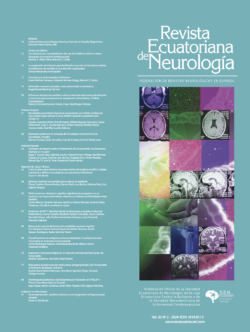Posterior reversible encephalopathy syndrome (PRES) is a transient clinical condition associated with a loss of cerebral vascular regulation. We present the case of a patient diagnosed with abdominal diffuse large B-cell lymphoma who presented to the emergency department with visual impairment, headache, and seizures. A brain magnetic resonance imaging showed T2 bilateral occipital hyperintensity and on diffusion-weighted imaging (DWI) and apparent diffusion coefficient (ADC) showed hyperintense signal, consistent with vasogenic edema compatible with PRES, with no additional findings on images or in cerebrospinal fluid. The only abnormal metabolic finding was hypercalcemia. Metastatic involvement of the central nervous system was ruled out. Medical management of the hypercalcemia was performed, achieving complete resolution of the patient’s symptoms with reversibility of the imaging alterations 6 weeks after the episode.
Linfoma No Hodgkin
Encefalopatía Posterior Reversible asociada a hipercalcemia maligna: una presentación poco usual. Posterior Reversible Encephalopathy associated with malignant hypercalcemia: an unusual presentation
Síndrome de Persona Rígida de Causa Paraneoplásica. Claves Diagnósticas en una Entidad Rara. Stiff Person Syndrome Of Paraneoplastic Cause. Diagnostic Keys In A Rare Entity
Introduction: Paraneoplastic disorders exert their effect through immunological mechanisms and not by direct invasion of the tumor; in this way tumors located outside the nervous system induce the production of antibodies against antigens: on the neu- ronal surface, intracellular or synaptic and affect distant sites from its location to either the central or peripheral nervous system, thus producing various clinical manifestations. One of these syndromes is the Stiff Person syndrome, which, apart from being a rare entity, occurs as a paraneoplastic syndrome in only 5% of cases.
Clinical Case: A 72-year-old male patient, a 2-month evolution that began with painful muscle spasms in the dorsal and lumbar region, evolved to rigidity with posture in axial and appendicular hyperextension, pseudospastic gait, hyperekplexia; due to the suspicion of Stiff Person syndrome a diagnostic work-up was begun finding high levels of Ab anti GAD65 and later a Non- Hodgkin’s Lymphoma. The patient received immunotherapy and cancer treatment.
Conclusion: Paraneoplastic syndromes must be identified according to the clinical phenotype and the determination of an- tineuronal antibodies. High suspicion and rapid diagnosis are necessary to achieve timely treatment and avoid permanent injury.
Leer artículo completo
Trombosis Venosa Cerebral en una Paciente con Enfermedad de Hodgkin y Embarazo: Presentación de Caso Clínico y Revisión de la Literatura.
Cerebral venous thrombosis is an uncommon problem with serious medical consequences. It presents with a wide range of signs and symptoms as any cerebral syndrome where neuroimaging plays a key role. Among the conditions that produce or predispose to venous thrombosis are hypercoagulable states, inherited or acquired. We report a case where the association of pregnancy and malignancy (Non-Hodgkin Lymphoma) induced the development of cerebral venous sinus thrombosis.





